Impact Location on a Fan-Ring Shaped High-Stiffened Panel Using Adaptive Energy Compensation Threshold Filtering Method
Abstract
:1. Introduction
2. Theory
2.1. Principle and Theory of AECTF Method
2.2. The Lamb Wave Characteristics of Impact Signal in Stiffened Panel
2.3. Energy Factor
2.4. Impact Signal Arrival Time Algorithm
2.5. Location Algorithm
- (1)
- Reasonably select the filter band according to the simulation result, which can improve the locating accuracy and stability.
- (2)
- The threshold amplification factor of each channel is not fixed, and it is scaled and compensated according to energy, which has strong adaptability.
- (3)
- It can ensure that the signals used for locating by each channel are S0 mode Lamb waves in the same frequency band, reducing the error.
- (4)
- The threshold benchmark based on multi-segment noise calculation is general, which can truly reflect the sensor response under the combined action of multiple influencing factors. At the same time, it is not easily affected by the selection of the noise start time.
- (5)
- Conditional recognition of signals exceeding the threshold is carried out to eliminate the effects of sudden interference.
3. Influence Analysis of Stiffeners on Lamb Wave Propagation Law
3.1. Finite Element Simulation Model
3.2. Effect of Stiffeners on Lamb Wave Velocity and Signal Head
3.3. Effect of Stiffeners on S0 Mode Lamb Wave
4. Experiments of Impact Source Localization in Stiffened Panel
4.1. Impact Signal Generation and Wave Velocity Measurement
4.2. Experimental System
5. Results
5.1. Locating Results without Filtering
5.2. Locating Results with Filtering
5.3. Locating Results with Fixed Parameter
6. Conclusions
- (1)
- The stiffener has almost no influence on the Lamb wave velocity, and the average wave velocity in each direction can be used as the impact locating wave velocity. When the Lamb wave passes through the same number of stiffeners, the amplitude of the first wave trough is basically the same. The more stiffeners the signal passes through, the more obvious the attenuation of the first wave trough is, and the same applies to the first wave crest.
- (2)
- The stiffener has a comb-filter effect on the S0 mode Lamb wave, and the number of passbands, the bandwidth and fluctuation of filter are related to the through-stiffener condition. When the number of stiffeners is two, there is a clear pass band in the 70–170 kHz band, the pass band bandwidth is narrow, below 100 kHz. When the number of stiffeners is 3, the energy factor changes gently, and a wide pass band exists when the frequency is lower than 250 kHz. Comprehensive energy factor and frequency characteristics, the energy of the 100–200 kHz band signal is relatively high, and the time domain resolution is high, which is suitable for locating.
- (3)
- The AECTF method proposed in this paper has high locating accuracy and stability. When the signal is not filtered, the average locating errors of 84.4% impact points are less than 30 mm. Selecting the appropriate frequency band to filter the impact signals can further improve the locating results. The locating result is optimal when using 100–200 kHz band filtering. The maximum absolute error of 32 points is 16.3 mm, the average absolute error is 7.0 mm, the average relative error is 0.86% and the error standard deviation is 3.5 mm. There are large error points in the locating results of fixed threshold amplification factor and fixed threshold. By comparing the calculated arrival time and the actual arrival time of the signals, it is known that if the threshold is too small, it will be intercepted by noise. If the threshold is too large, the threshold will skip the S0 mode head. The AECTF method can adaptively acquire the arrival time of the S0 mode.
Author Contributions
Funding
Conflicts of Interest
References
- Shan, M.H.; Guo, J.; Gill, E. Review and comparison of active space debris capturing and removal methods. Prog. Aerosp. Sci. 2016, 80, 18–32. [Google Scholar] [CrossRef]
- Schildknecht, T. Optical surveys for space debris. Astron. Astrophys. Rev. 2007, 14, 41–111. [Google Scholar] [CrossRef]
- Wright, D. Space debris. Phys. Today 2007, 60, 35–40. [Google Scholar] [CrossRef]
- Valk, S.; Lemaitre, A.; Deleflie, F. Semi-analytical theory of mean orbital motion for geosynchronous space debris under gravitational influence. Adv. Space Res. 2009, 43, 1070–1082. [Google Scholar] [CrossRef]
- Valk, S.; Lemaitre, A.; Anselmo, L. Analytical and semi-analytical investigations of geosynchronous space debris with high area-to-mass ratios. Adv. Space Res. 2008, 41, 1077–1090. [Google Scholar] [CrossRef]
- Liou, J.C.; Johnson, N.L. Planetary science - Risks in space from orbiting debris. Science 2006, 311, 340–341. [Google Scholar] [CrossRef]
- Liu, Z.D.; Pang, B.J. A method based on acoustic emission for locating debris cloud impact. In Proceedings of the 4th International Conference on Experimental Mechanics, Singapore, 18–20 November 2009. [Google Scholar]
- Xie, W.H.; Meng, S.H.; Ding, L.; Jin, H.; Du, S.Y.; Han, G.K.; Wang, L.B.; Xu, C.H.; Scarpa, F.; Chi, R.Q. High-temperature high-velocity impact on honeycomb sandwich panels. Compos. Part B-Eng. 2018, 138, 1–11. [Google Scholar] [CrossRef] [Green Version]
- Zhang, Z.Y.; Chi, R.Q.; Pang, B.J.; Guan, G.S. Numerical simulation of projectile oblique impact on microspacecraft structure. Int. J. Aerosp. Eng. 2017. Available online: https://www.hindawi.com/journals/ijae/2017/1015674/ (accessed on 28 April 2019). [CrossRef]
- Schaub, H.; Jasper, L.E.Z.; Anderson, P.V.; McKnight, D.S. Cost and risk assessment for spacecraft operation decisions caused by the spacedebris environment. Acta Astronaut. 2015, 113, 66–79. [Google Scholar] [CrossRef]
- Grossman, E.; Gouzman, I.; Verker, R. Debris/Micrometeoroid impacts and synergistic effects on spacecraft materials. MRS Bull. 2010, 35, 41–47. [Google Scholar] [CrossRef]
- Tommei, G.; Milani, A.; Rossi, A. Orbit determination of space debris: Admissible regions. Celest. Mech. Dyn. Astr. 2007, 97, 289–304. [Google Scholar] [CrossRef]
- Alby, F.; Lansard, E.; Michal, T. Collision of cerise with space debris. In Proceedings of the 2nd European Conference on Space Debris, ESOC, Darmstadt, Germany, 17–19 March 1997; p. 589. [Google Scholar]
- Golub, M.V.; Shpak, A.N. Semi-analytical hybrid approach for the simulation of layered waveguide with a partially debonded piezoelectric structure. Appl. Math. Model. 2019, 65, 234–255. [Google Scholar] [CrossRef]
- Reusser, R.S.; Chimenti, D.E.; Roberts, R.A.; Holland, S.D. Guided plate wave scattering at vertical stiffeners and its effect on source location. Ultrasonics 2012, 52, 687–693. [Google Scholar] [CrossRef]
- Reusser, R.S.; Holland, S.D.; Chimenti, D.E.; Roberts, R.A. Reflection and transmission of guided ultrasonic plate waves by vertical stiffeners. J. Acoust. Soc. Am. 2014, 136, 170–182. [Google Scholar] [CrossRef] [PubMed]
- Ghandourah, E. Large Plate Monitoring Using Guided Ultrasonic Waves. Ph.D. Thesis, University College London, London, UK, 2015. Available online: http://discovery.ucl.ac.uk/1463979/ (accessed on 28 April 2019).
- Santhanam, S.; Demirli, R. Reflection of lamb waves obliquely incident on the free edge of a plate. Ultrasonics 2013, 53, 271–282. [Google Scholar] [CrossRef] [PubMed]
- Haider, M.F.; Bhuiyan, M.Y.; Poddar, B.; Lin, B.; Giurgiutiu, V. Analytical and experimental investigation of the interaction of Lamb waves in a stiffened aluminum plate with a horizontal crack at the root of the stiffener. J. Sound Vib. 2018, 431, 212–225. [Google Scholar] [CrossRef]
- Alleyne, D.N.; Cawley, P. The interaction of Lamb waves with defects. IEEE Trans. Ultrason. Ferroelectr. 1992, 39, 381–397. [Google Scholar] [CrossRef] [PubMed]
- Benmeddour, F.; Grondel, S.; Assaad, J.; Moulin, E. Study of the fundamental Lamb modes interaction with asymmetrical discontinuities. NDT&E Int. 2008, 41, 330–340. [Google Scholar]
- Tuzzolino, A.J.; McKibben, R.B.; Simpson, J.A.; BenZvi, S.; Voss, H.D.; Gursky, H. The Space Dust (SPADUS) instrument aboard the Earth-orbiting ARGOS spacecraft: I—instrument description. Planet. Space Sci. 2001, 49, 689–703. [Google Scholar] [CrossRef]
- Tuzzolino, A.J.; McKibben, R.B.; Simpson, J.A.; BenZvi, S.; Voss, H.D.; Gursky, H. The Space Dust (SPADUS) instrument aboard the Earth-orbiting ARGOS spacecraft: II- results from the first 16 months of flight. Planet. Space Sci. 2001, 49, 705–729. [Google Scholar] [CrossRef]
- Jia, Z.G.; Ren, L.; Li, H.N.; Sun, W. Pipeline leak localization based on FBG hoop strain sensors combined with BP neural network. Appl. Sci. 2018, 8, 146. [Google Scholar] [CrossRef]
- Rickman, S.L.; Richards, W.L.; Christiansen, E.L.; Piazza, A.; Pena, F.; Parker, A.R. Micrometeoroid/orbital debris (MMOD) impact detection and location using fiber optic bragg grating sensing technology. Procedia Eng. 2017, 188, 233–240. [Google Scholar] [CrossRef]
- Yeager, M.; Whittaker, A.; Todd, M.; Kim, H.; Key, C.; Gregory, W. Impact detection and characterization in composite laminates with embedded fiber Bragg gratings. In Proceedings of the 6th Asia-Pacific Workshop on Structural Health Monitoring (APWSHM), Hobart, Australia, 7–9 December 2016; pp. 156–162. [Google Scholar]
- Ongpeng, J.M.C.; Oreta, A.W.C.; Hirose, S. Monitoring damage using acoustic emission source location and computational geometry in reinforced concrete beams. Appl. Sci. 2018, 8, 189. [Google Scholar] [CrossRef]
- Bartoli, I.; Salamone, S.; di Scalea, F.L.; Rhymer, J.; Kim, H. Impact force identification in aerospace panels by an inverse ultrasonic guided wave problem. In Proceedings of the Conference on Health Monitoring of Structural and Biological Systems 2011, San Diego, CA, USA, 7–10 March 2011. [Google Scholar]
- Zhou, Z.L.; Rui, Y.C.; Zhou, J.; Dong, L.J.; Chen, L.J.; Cai, X.; Cheng, R.S. A new closed-form solution for acoustic emission source location in the presence of outliers. Appl. Sci. 2018, 8, 949. [Google Scholar] [CrossRef]
- Salamone, S.; Bartoli, I.; Rhymer, J.; di Scalea, F.L.; Kim, H. Validation of the piezoelectric rosette technique for locating impacts in complex aerospace panels. In Proceedings of the Conference on Health Monitoring of Structural and Biological Systems 2011, San Diego, CA, USA, 7–10 March 2011. [Google Scholar]
- Wu, J.C.; Xu, C.H.; Qi, B.X.; Hernandez, F.C.R. Detection of impact damage on PVA-ECC beam using infrared thermography. Appl. Sci. 2018, 8, 839. [Google Scholar] [CrossRef]
- Liu, Z.H.; Wang, J.M.; Kong, F.J.; Liu, W.G.; Li, H.B. A method for locating space debris impact source based on PVDF films. In Proceedings of the 11th International Space Conference on Protection of Materials and Structures from Space Environment (ICPMSE), Lijiang, China, 19–23 May 2014; pp. 509–515. [Google Scholar]
- Qi, B.X.; Kong, Q.Z.; Qian, H.; Patil, D.; Lim, I.; Li, M.; Liu, D.; Song, G.B. Study of impact damage in PVA-ECC beam under low-velocity impact loading using piezoceramic transducers and PVDF thin-film transducers. Sensors 2018, 18, 671. [Google Scholar] [CrossRef] [PubMed]
- Han, J.; Li, D.; Zhao, C.M.; Wang, X.Y.; Li, J.; Wu, X.Z. Highly sensitive impact sensor based on PVDF-TrFE/Nano-ZnO composite thin film. Sensors 2019, 19, 830. [Google Scholar] [CrossRef]
- Shrestha, P.; Kim, J.H.; Park, Y.; Kim, C.G. Impact localization on composite structure using FBG sensors and novel impact localization technique based on error outliers. Compos. Struct. 2016, 142, 263–271. [Google Scholar] [CrossRef]
- Wang, J.K.; Huo, L.S.; Liu, C.G.; Peng, Y.C.; Song, G.B. Feasibility study of real-time monitoring of pin connection wear using acoustic emission. Appl. Sci. 2018, 8, 1775. [Google Scholar] [CrossRef]
- Sanchez, N.; Meryane, V.; Ortiz-Bernardin, A. A novel impact identification algorithm based on a linear approximation with maximum entropy. Smart Mater. Struct. 2016, 25, 095050. [Google Scholar] [CrossRef]
- Zhang, L.; Ozevin, D.; He, D.; Hardman, W.; Timmons, A. A method to decompose the streamed acoustic emission signals for detecting embedded fatigue crack signals. Appl. Sci. 2018, 8, 7. [Google Scholar] [CrossRef]
- Meruane, V.; Veliz, P.; Droguett, E.L.; Ortiz-Bernardin, A. Impact location and quantification on an aluminum sandwich panel using principal component analysis and linear approximation with maximum entropy. Entropy 2017, 19, 137. [Google Scholar] [CrossRef]
- Teng, X.D.; Zhang, X.; Fan, Y.T.; Zhang, D. Evaluation of cracks in metallic material using a self-organized data-driven model of acoustic echo-signal. Appl. Sci. 2019, 9, 95. [Google Scholar] [CrossRef]
- Chen, C.L.; Li, Y.L.; Yuan, F.G. Impact source identification in finite isotropic plates using a time-reversal method: experimental study. Smart Mater. Struct. 2012, 21, 105025. [Google Scholar] [CrossRef]
- Salmanpour, M.S.; Khodaei, Z.S.; Aliabadi, M.H. Transducer placement optimisation scheme for a delay and sum damage detection algorithm. Struct. Control Health 2017, 24, e1898. [Google Scholar] [CrossRef]
- Park, W.H.; Packo, P.; Kundu, T. Acoustic source localization in an anisotropic plate without knowing its material properties—A new approach. Ultrasonics 2017, 79, 9–17. [Google Scholar] [CrossRef]
- Sen, N.; Kundu, T. A new wave front shape-based approach for acoustic source localization in an anisotropic plate without knowing its material properties. Ultrasonics 2018, 87, 20–32. [Google Scholar] [CrossRef]
- Marino-Merlo, E.; Bulletti, A.; Giannelli, P.; Calzolai, M.; Capineri, L. Analysis of errors in the estimation of impact positions in plate-like structure through the triangulation formula by piezoelectric sensors monitoring. Sensors 2018, 18, 3426. [Google Scholar] [CrossRef]
- Jiao, J.P.; Meng, X.J.; He, C.F.; Bin, W. Nonlinear Lamb wave-mixing technique for micro-crack detection in plates. NDT&E Int. 2017, 85, 63–71. [Google Scholar]
- Moreau, L.; Velichko, A.; Wilcox, P.D. Accurate finite element modelling of guided wave scattering from irregular defects. NDT&E Int. 2012, 45, 46–54. [Google Scholar]
- Maio, L.; Ricci, F.; Memmolo, V.; Monaco, E.; Boffa, N.D. Application of laser Doppler vibrometry for ultrasonic velocity assessment in a composite panel with defect. Compos. Struct. 2018, 184, 1030–1039. [Google Scholar] [CrossRef]
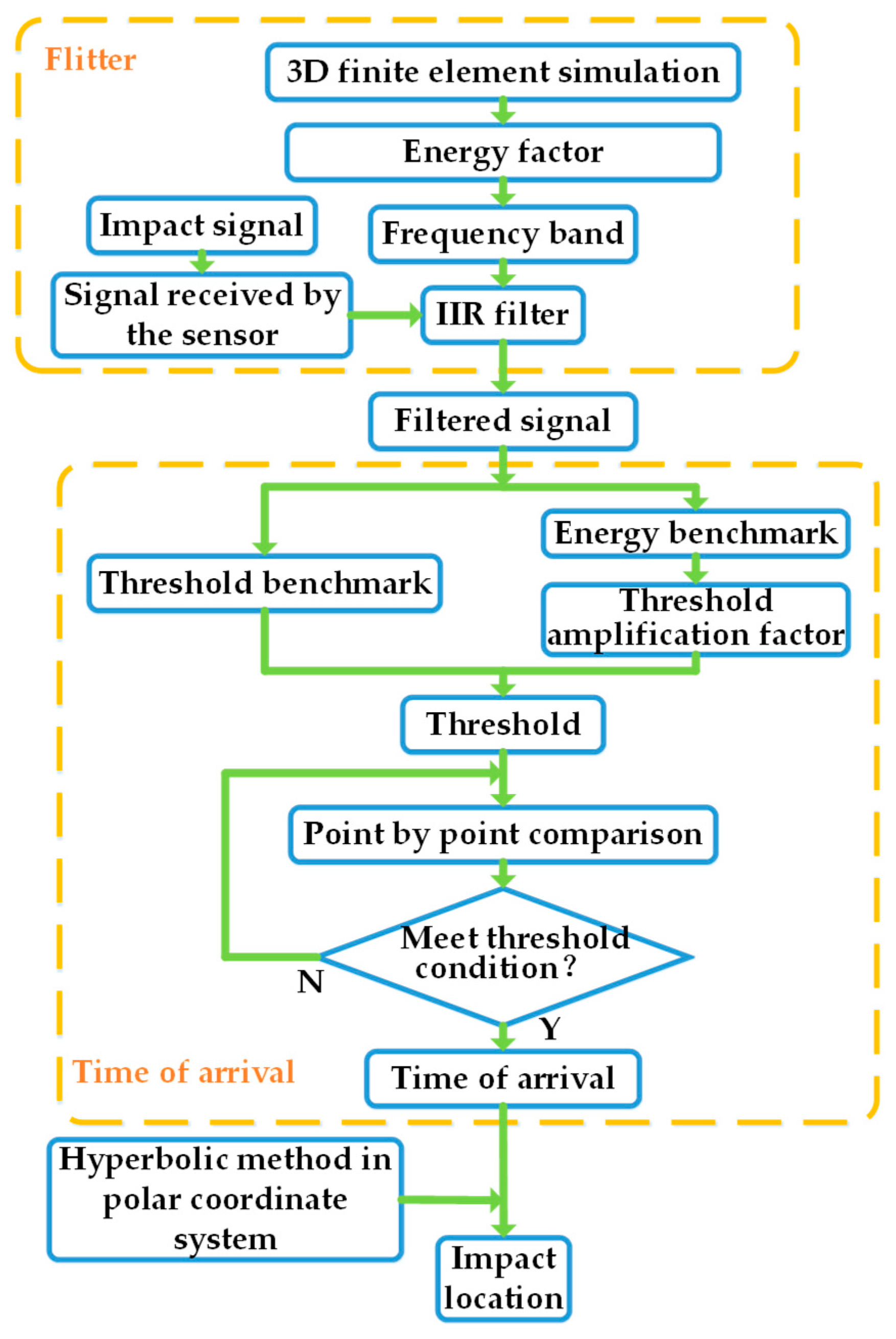

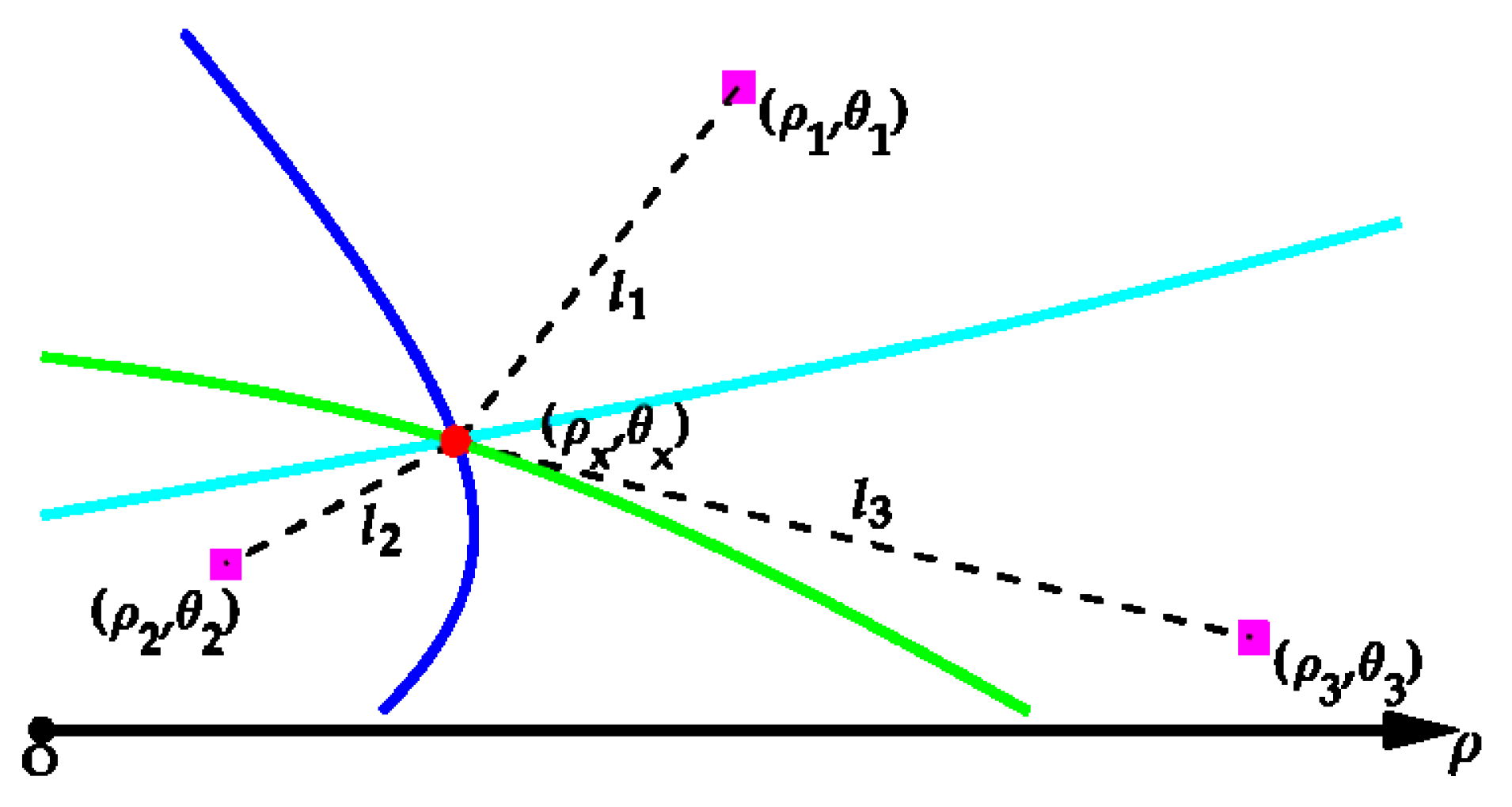
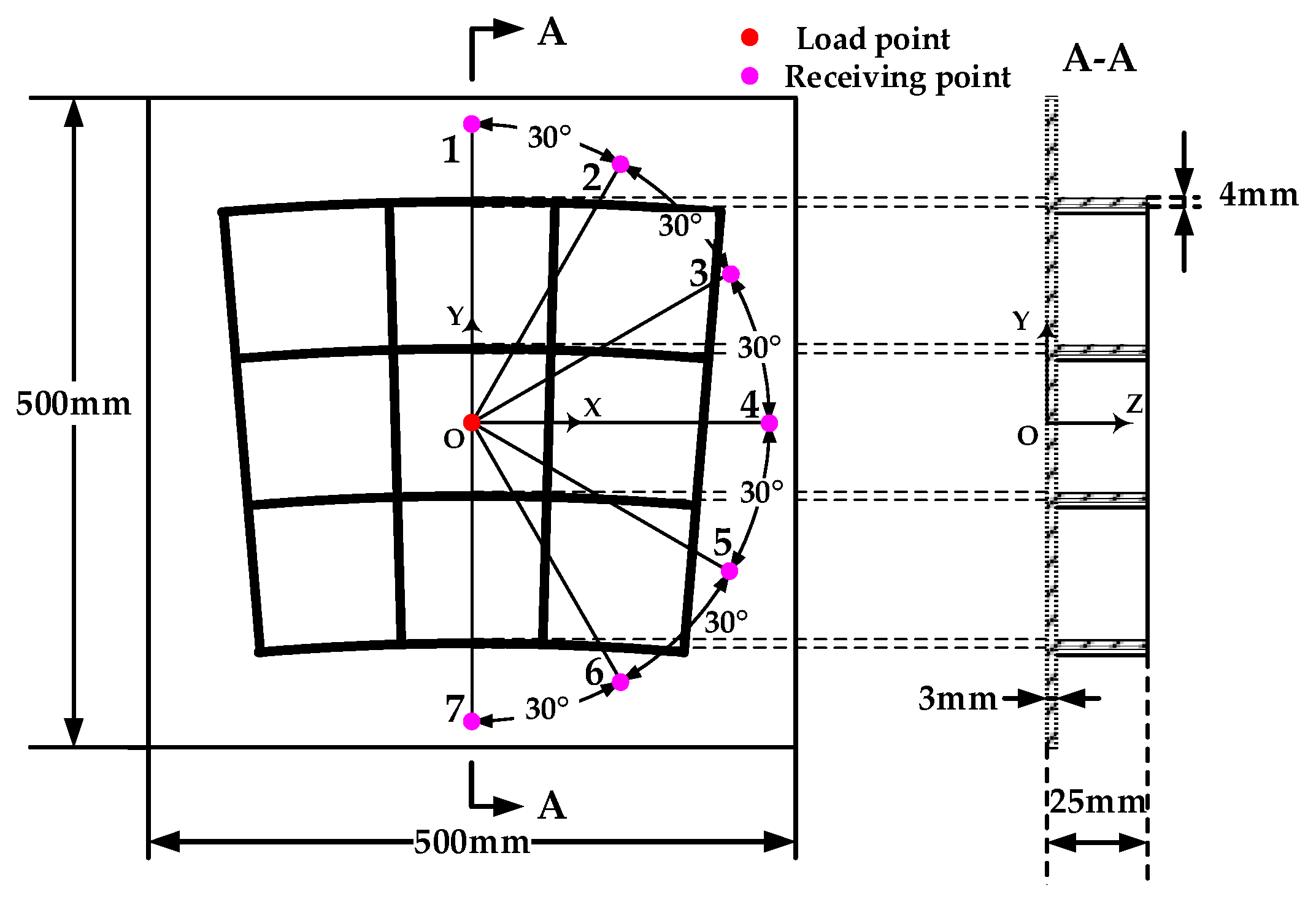

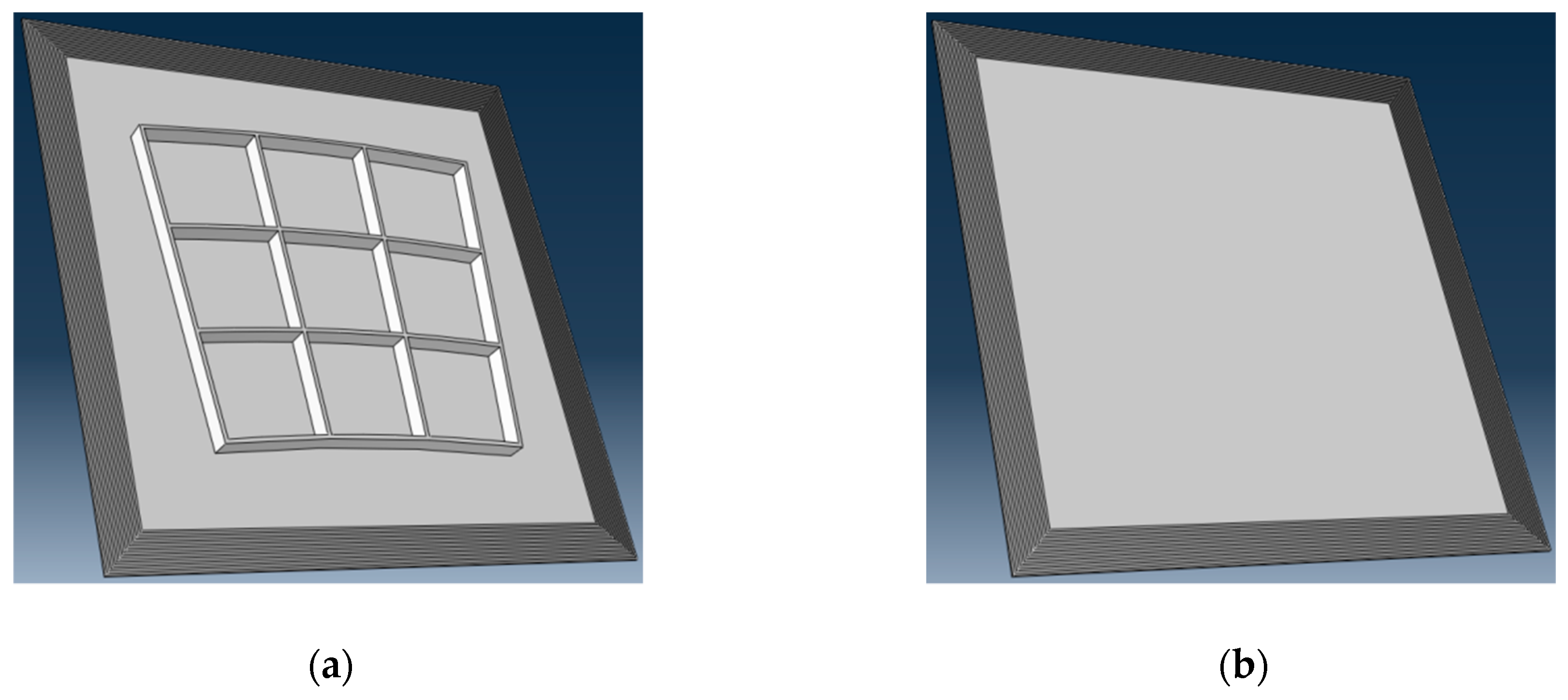
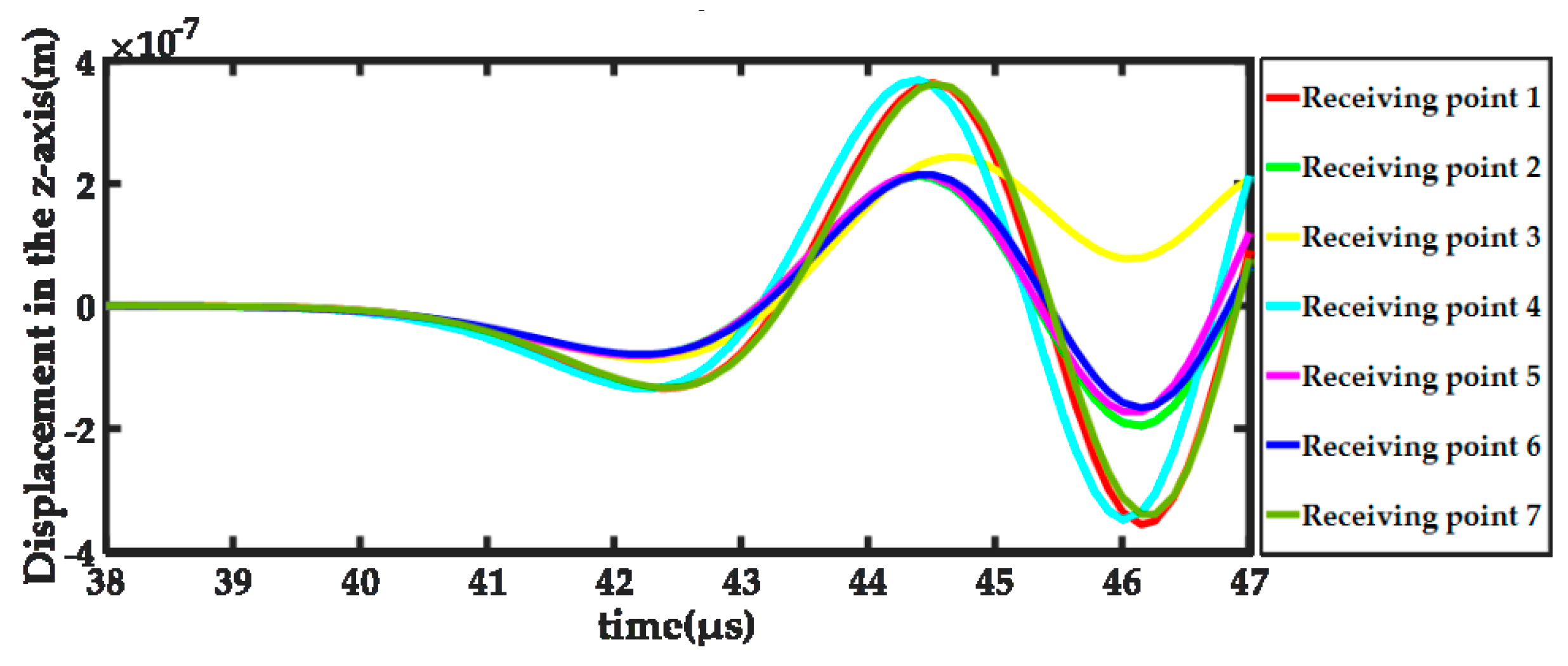

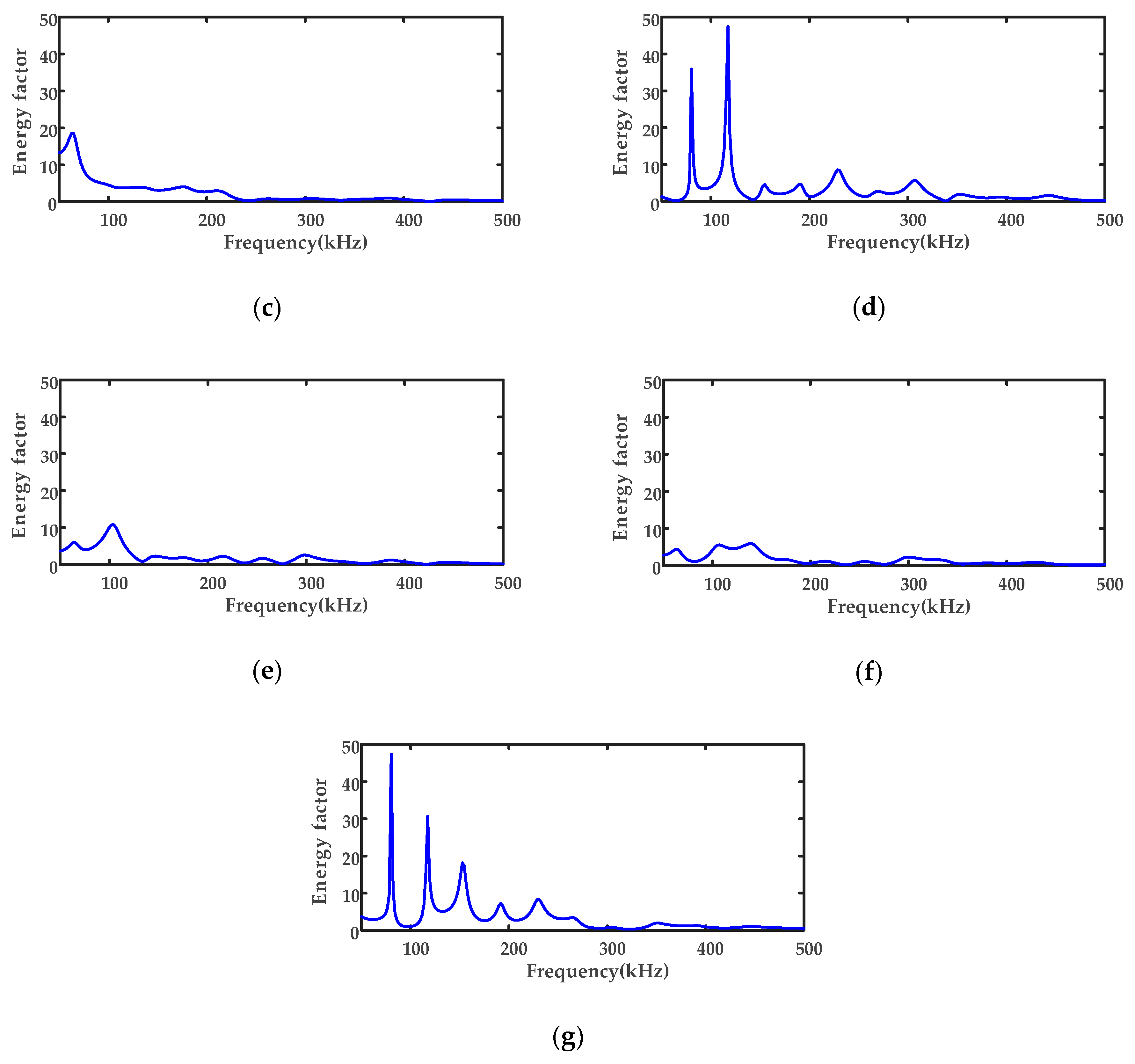
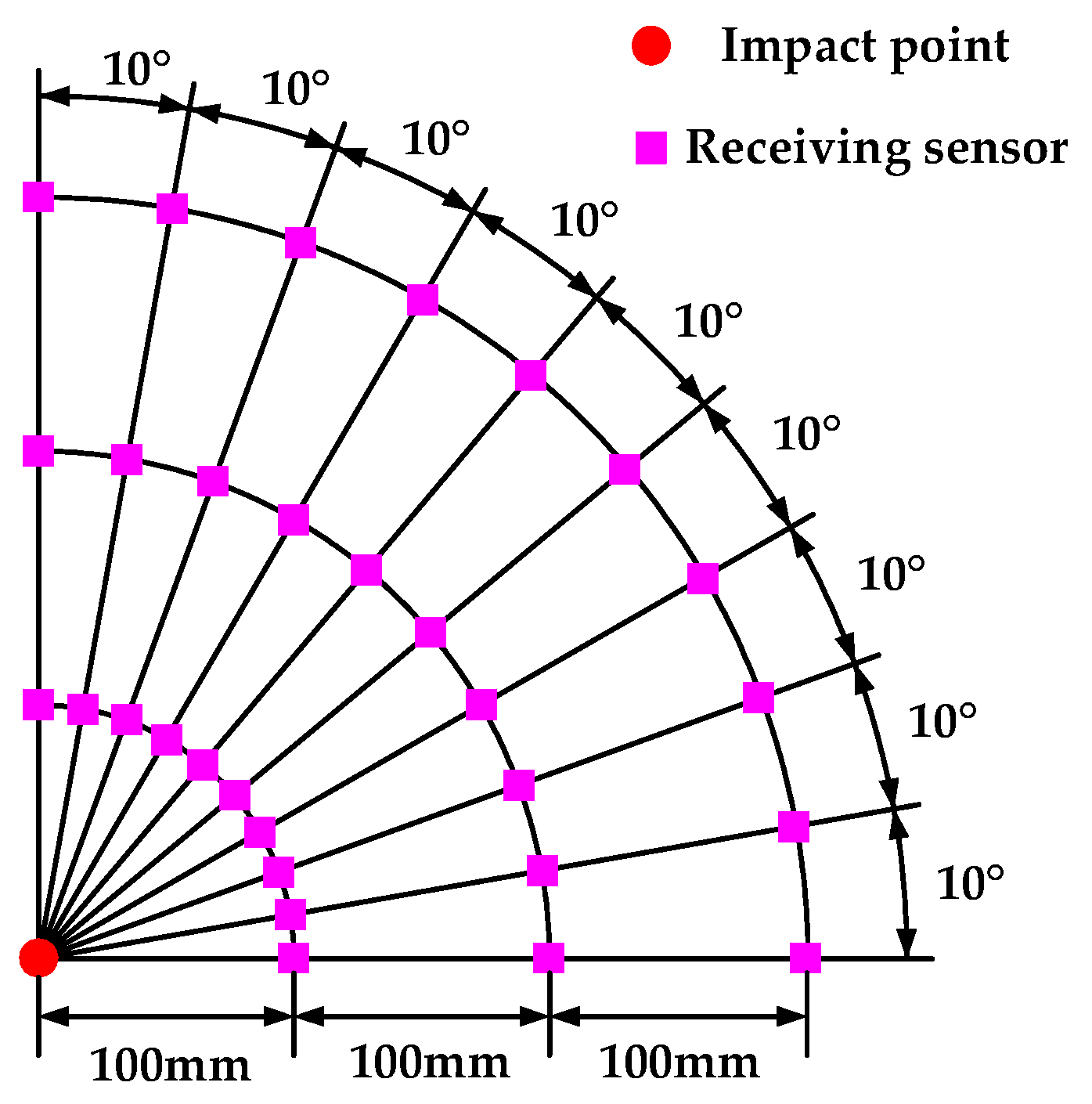

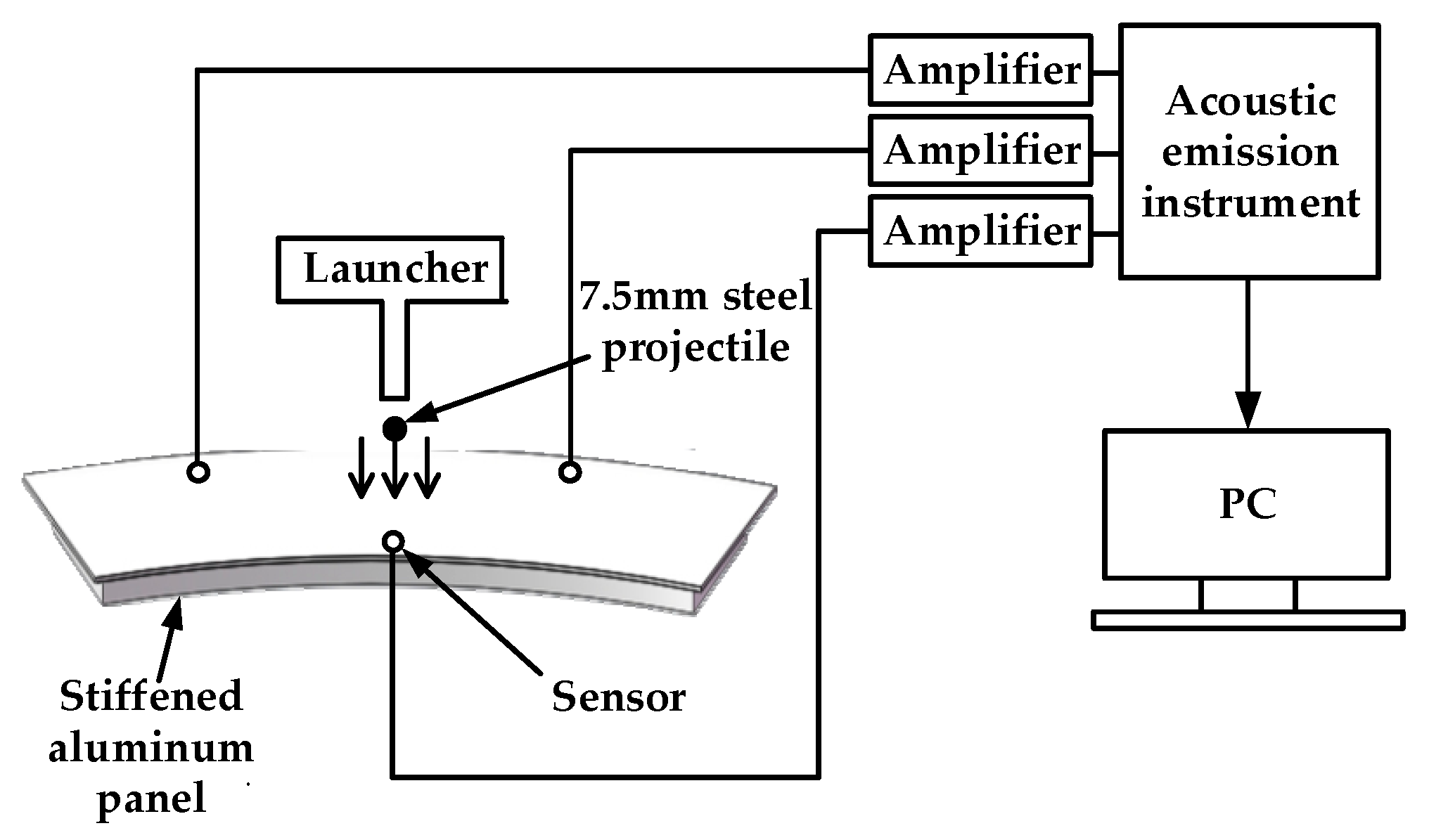
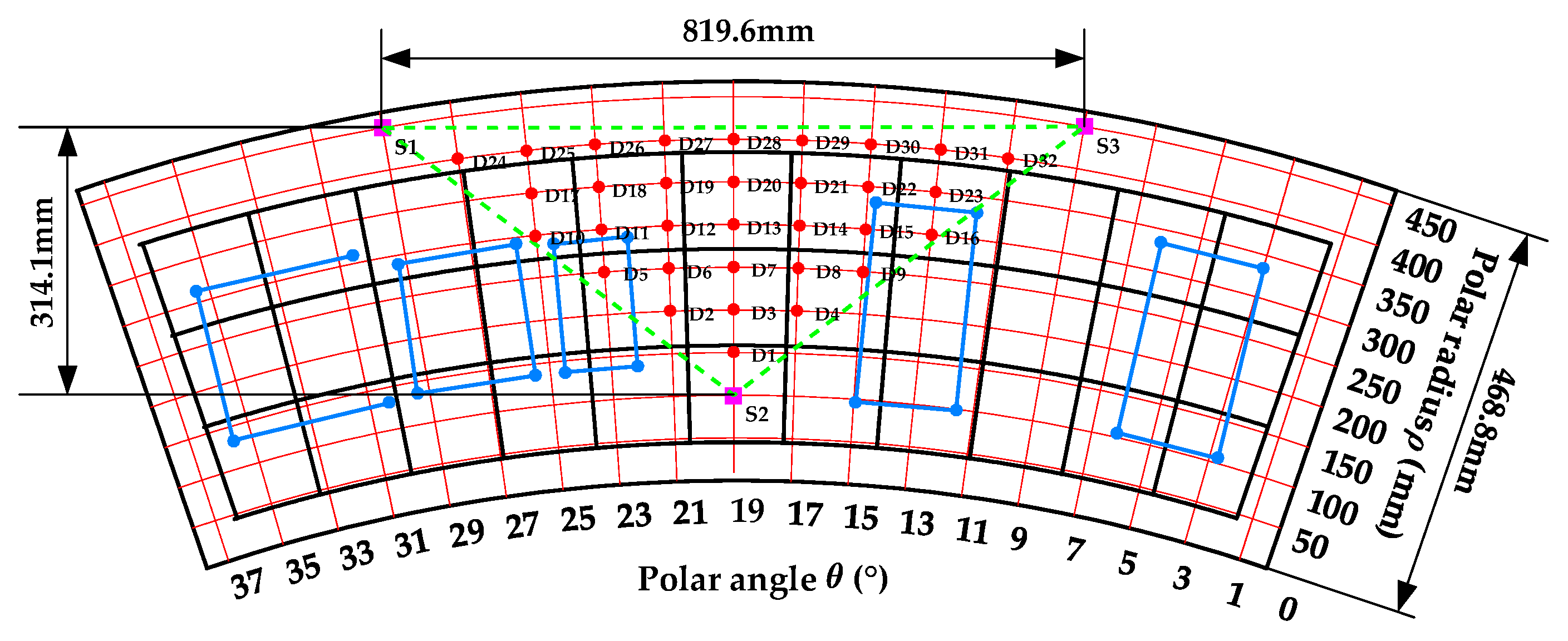

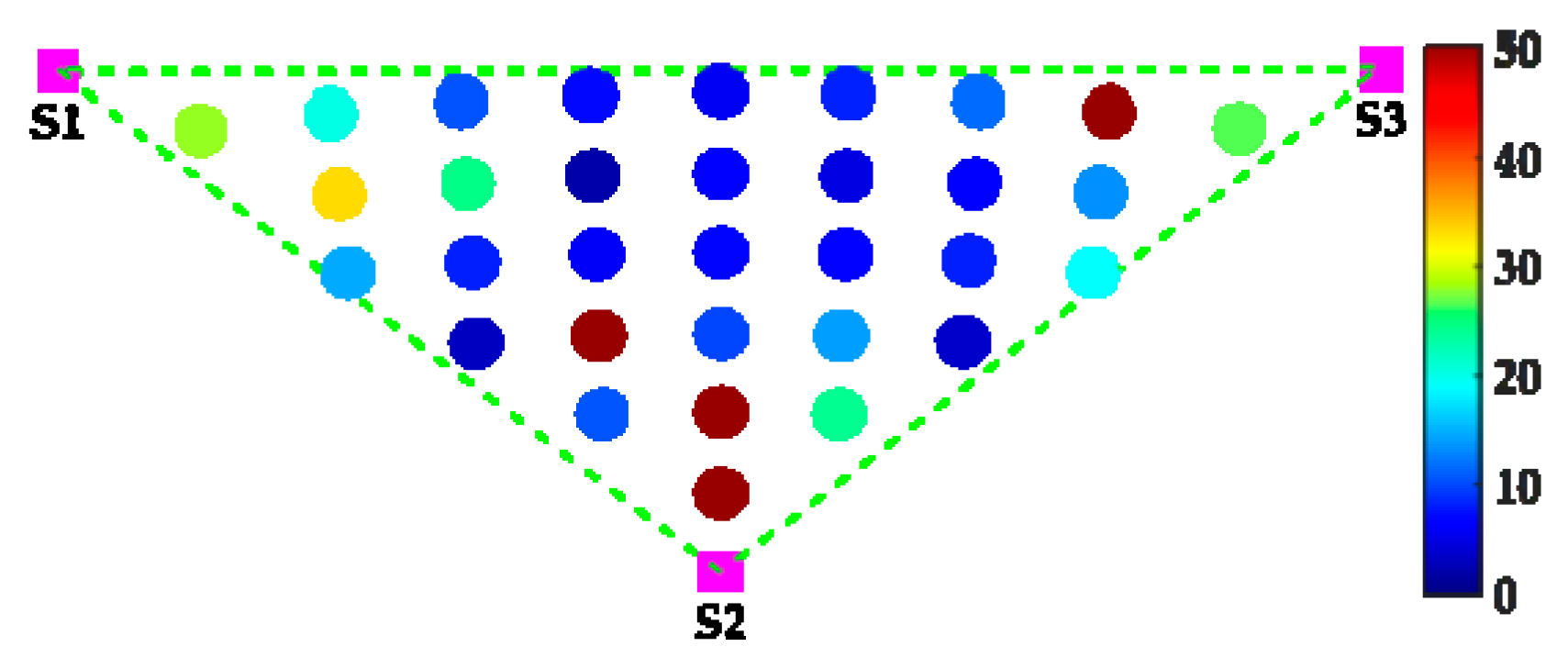
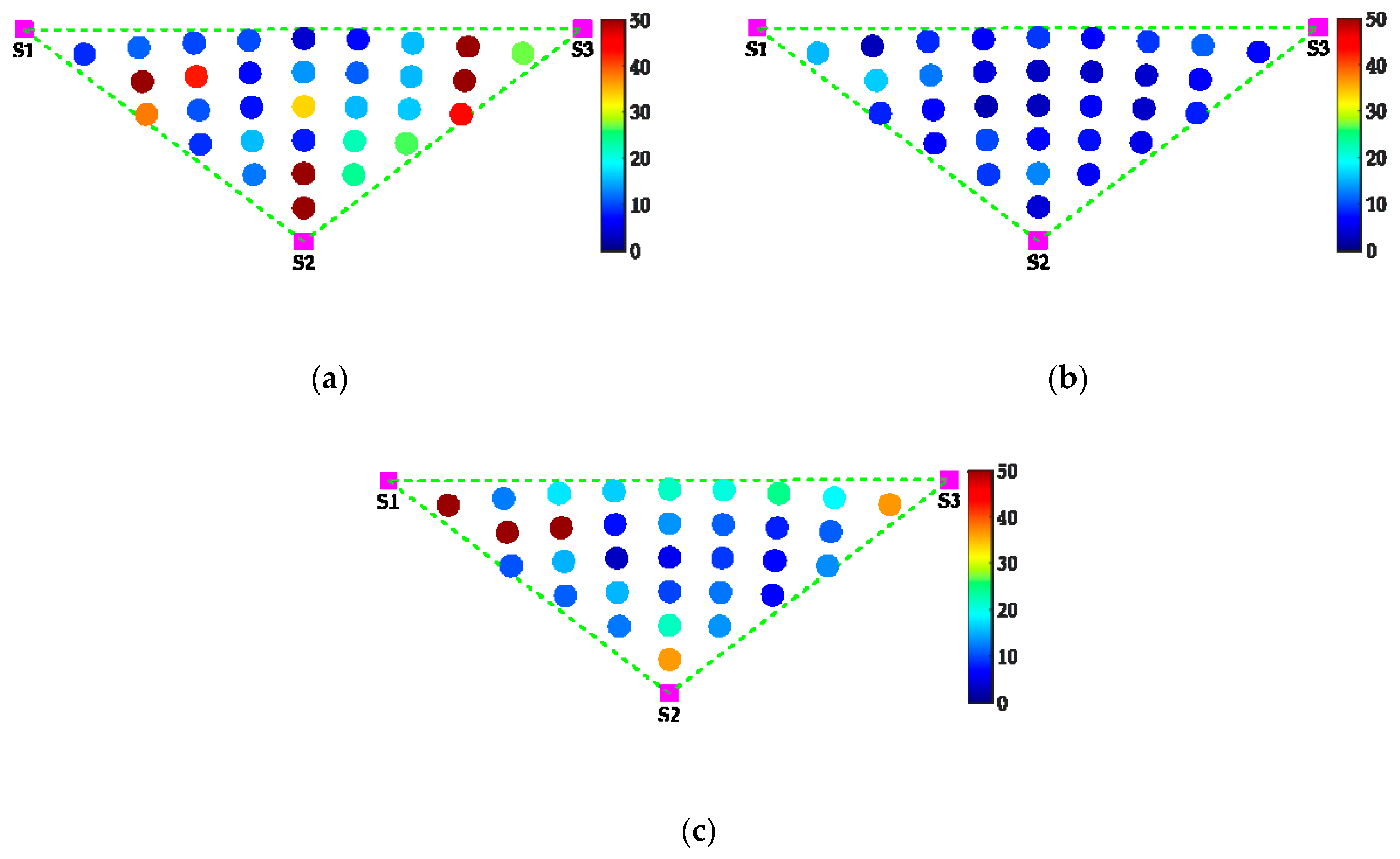
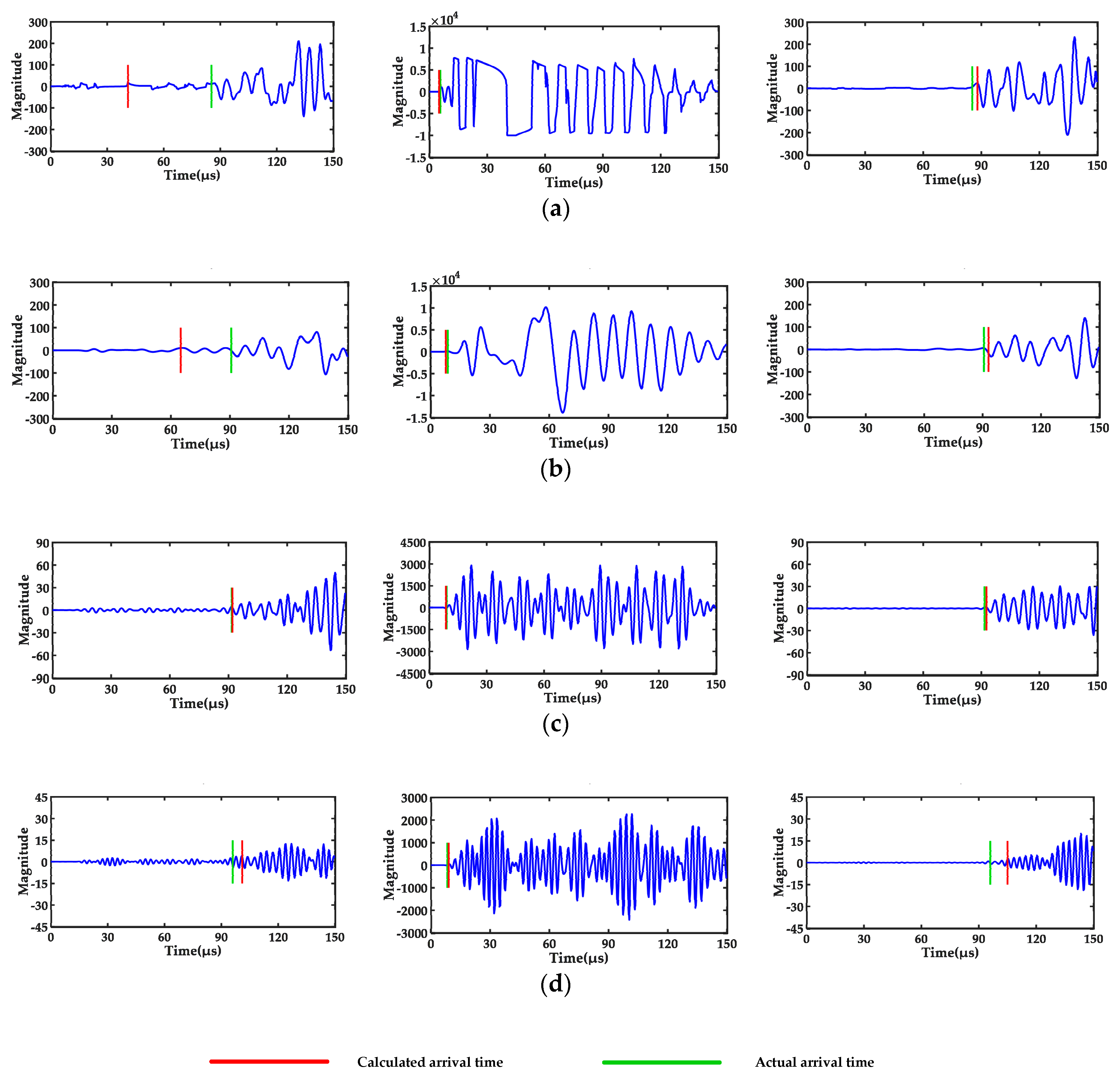

| Aluminum Designation | ρ (g/cm3) | E (MPa) | μ |
|---|---|---|---|
| 5A06 | 2.64 | 71,000 | 0.32 |
| Number of experiments | 1 | 2 | 3 | 4 | 5 | 6 | 7 | 8 | 9 | 10 |
| Velocity (m/s) | 21.3 | 21.4 | 21.4 | 20.9 | 21.2 | 21.3 | 19.4 | 21.1 | 21.3 | 20.9 |
| Angle (°) | 0 | 10 | 20 | 30 | 40 | 50 | 60 | 70 | 80 | 90 |
| Wave velocity (km/s) | 5.43 | 5.46 | 5.47 | 5.42 | 5.40 | 5.45 | 5.41 | 5.43 | 5.46 | 5.40 |
| Dimension Parameter | Value | Dimension Parameter | Value |
|---|---|---|---|
| Outer diameter (mm) | 2378.8 | Height of stiffener (mm) | 22.0 |
| Inner diameter (mm) | 1910.0 | Thickness of stiffener (mm) | 4.0 |
| Central angle (°) | 37.8 | Circumferential spacing (°) | 3.2 |
| Width (mm) | 468.8 | Radial spacing (mm) | 112.0 |
| Thickness (mm) | 3.0 | Material | Aluminum 5A06 |
| Different Processing Methods | Average Absolute Error (mm) | Average Relative Error | Error Standard Deviation (mm) |
|---|---|---|---|
| Without filtering | 25.4 | 3.10% | 38.2 |
| With 0–100 kHz filtering | 28.6 | 3.49% | 29.7 |
| With 100–200 kHz filtering | 7.0 | 0.86% | 3.5 |
| With 200–300 kHz filtering | 19.9 | 2.43% | 18.8 |
| Fixed threshold amplification factor with 100–200 kHz filtering | 17.5 | 2.13% | 23.1 |
| Fixed threshold with 100–200 kHz filtering | 27.8 | 3.39% | 41.0 |
© 2019 by the authors. Licensee MDPI, Basel, Switzerland. This article is an open access article distributed under the terms and conditions of the Creative Commons Attribution (CC BY) license (http://creativecommons.org/licenses/by/4.0/).
Share and Cite
Li, Y.; Wang, Z.; Rui, X.; Qi, L.; Liu, J.; Yang, Z. Impact Location on a Fan-Ring Shaped High-Stiffened Panel Using Adaptive Energy Compensation Threshold Filtering Method. Appl. Sci. 2019, 9, 1763. https://doi.org/10.3390/app9091763
Li Y, Wang Z, Rui X, Qi L, Liu J, Yang Z. Impact Location on a Fan-Ring Shaped High-Stiffened Panel Using Adaptive Energy Compensation Threshold Filtering Method. Applied Sciences. 2019; 9(9):1763. https://doi.org/10.3390/app9091763
Chicago/Turabian StyleLi, Yibo, Zhe Wang, Xiaobo Rui, Lei Qi, Jiawei Liu, and Zi Yang. 2019. "Impact Location on a Fan-Ring Shaped High-Stiffened Panel Using Adaptive Energy Compensation Threshold Filtering Method" Applied Sciences 9, no. 9: 1763. https://doi.org/10.3390/app9091763
APA StyleLi, Y., Wang, Z., Rui, X., Qi, L., Liu, J., & Yang, Z. (2019). Impact Location on a Fan-Ring Shaped High-Stiffened Panel Using Adaptive Energy Compensation Threshold Filtering Method. Applied Sciences, 9(9), 1763. https://doi.org/10.3390/app9091763





